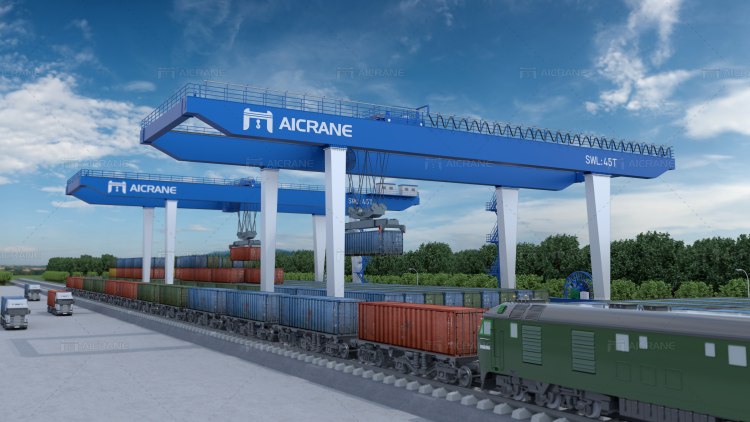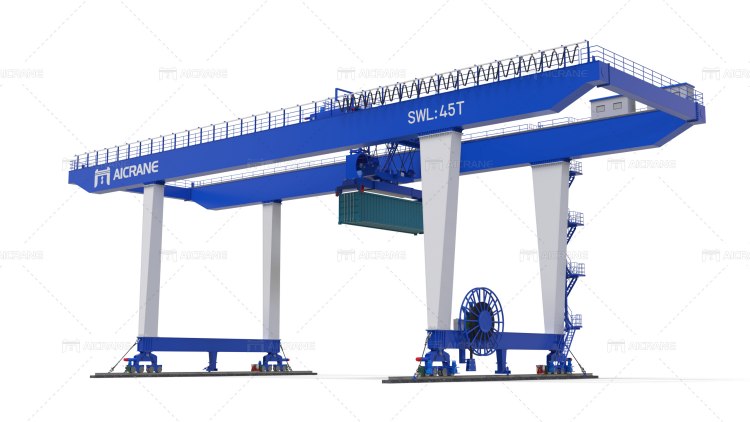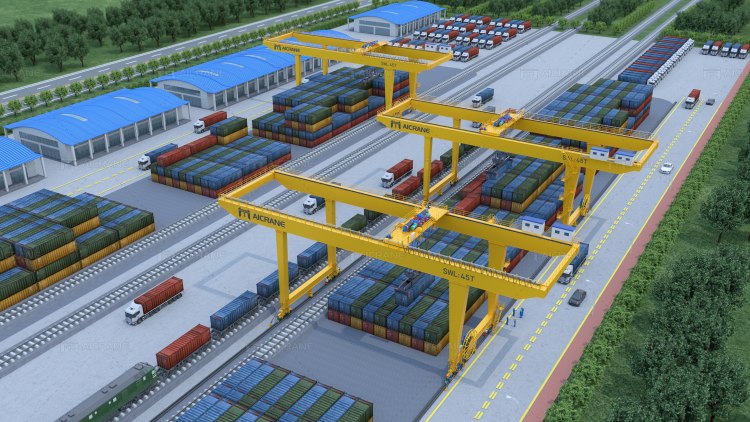Container handling gantry cranes play a crucial role in the efficient movement and management of shipping containers in ports, intermodal yards, and container terminals. These robust and powerful cranes are specifically designed to handle the unique challenges posed by containerized cargo. This article explores the features, benefits, operation training, and maintenance practices associated with container handling gantry cranes.

Features of Container Handling Gantry Crane
High Load Capacity: Container handling gantry cranes are engineered to handle heavy loads, typically ranging from 20 to 100 tons or more. They possess the strength and lifting capacity required to handle fully loaded shipping containers.
Long Outreach: These cranes are equipped with long outreach capabilities, allowing them to reach across multiple rows of containers. This feature ensures efficient loading and unloading operations, minimizing the need for repositioning.
Spreader Beams: Container handling gantry cranes are equipped with spreader beams, which are adjustable frames that secure and lift shipping containers. The spreader beams can be adjusted to fit different container sizes, ensuring versatility in container handling operations.
Mobility: Some container handling gantry cranes are designed to be mobile, capable of moving along a set of rails or tracks. This mobility enables them to cover a larger area and handle containers in different locations within the terminal or yard.

Benefits of Container Handling Gantry Crane
Increased Efficiency: Container handling gantry cranes streamline the loading and unloading process, minimizing downtime and maximizing productivity. Their high load capacity and long outreach capabilities enable quick and efficient container transfers.
Versatile Handling: These cranes can handle a wide range of container sizes, including standard twenty-foot equivalent units (TEUs) and forty-foot TEUs. The adjustable spreader beams accommodate various container configurations, allowing for seamless operations.
Safety: Container handling gantry cranes incorporate safety features such as anti-collision systems, load monitoring devices, and emergency stop buttons. These features help prevent accidents, protect personnel, and safeguard cargo.
Reduced Labor Costs: By automating container handling operations, container handling gantry cranes minimize the need for manual labor, leading to cost savings. They improve operational efficiency while reducing the risks associated with manual lifting.

Operation Training for Container Handling Gantry Crane
Proper operation training is essential to ensure safe and efficient use of container handling gantry cranes. Operators should receive comprehensive training covering the following areas:
Crane Controls and Instrumentation: Operators should become familiar with the various controls, indicators, and instruments of the gantry crane. They should understand how to interpret load capacity displays, monitor operating parameters, and respond to alarms or warnings.
Safety Procedures: Safety should be a primary focus during operation training. Operators should be trained in emergency procedures, including how to respond to power failures, lifting equipment malfunctions, or adverse weather conditions. They should also understand the importance of maintaining a safe distance from moving parts and operating within load capacity limits.
Load Handling and Spreader Beam Operations: Proper techniques for attaching, lifting, and releasing containers using the spreader beams should be taught. Operators should understand how to position the spreader beams accurately and secure containers safely.
Communication and Signaling: Effective communication and signaling protocols between crane operators and ground personnel are critical. Operators should be trained in standard hand signals and radio communication procedures to ensure smooth and coordinated operations.
Maintenance Practices for Container Handling Gantry Crane
Regular maintenance is vital to ensure the optimal performance and longevity of container handling gantry cranes. Key maintenance practices include:
Lubrication: Regular lubrication of moving parts, such as gears, bearings, and cables, is essential to reduce friction and prevent premature wear. Lubrication schedules should be followed, and high-quality lubricants should be used.
Structural Inspection: Periodic inspections should be conducted to assess the structural integrity of the crane, including the gantry frame, legs, and supporting structures. Any signs of corrosion, fatigue, or deformation should be addressed promptly.
Electrical System Maintenance: The electrical system, including motors, controls, and wiring, should be inspected and tested regularly. Connections should be checked for tightness, and any damaged or worn-out components should be repaired or replaced.
Component Inspections: Critical components such as wire ropes, hooks, spreader beams, and hydraulic systems should be inspected for wear, damage, or signs of malfunction. Any defects should be addressed to maintain safe and reliable operations.
Container handling gantry cranes play a vital role in the efficient movement and management of shipping containers in various industrial sectors. Their features, such as high load capacity, long outreach, and adjustable spreader beams, enable seamless container handling operations. The benefits of increased efficiency, versatile handling, safety, and reduced labor costs make them indispensable in container terminals and ports. Proper operation training ensures safe and efficient use of these cranes, while regular maintenance practices promote optimal performance and longevity. By adhering to proper operation and maintenance guidelines, industries can harness the full potential of rail mounted container cranes, optimizing container logistics and enhancing overall productivity.
